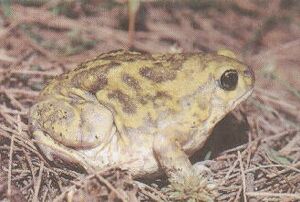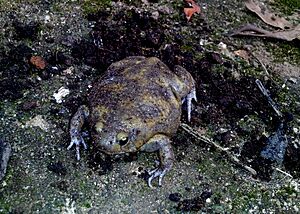Uperodon systoma facts for kids
Quick facts for kids Uperodon systoma |
|
|---|---|
 |
|
| Conservation status | |
| Scientific classification | |
| Synonyms | |
|
Rana systoma Schneider, 1799 |
The Uperodon systoma is a special type of narrow-mouthed frog. You might also hear it called the indistinct frog, marbled balloon frog, or lesser balloon frog. These frogs live in several countries, including Pakistan, India, Nepal, and Sri Lanka.
What Does It Look Like?
As its common names suggest, the Uperodon systoma looks quite round and stout. It has a body that seems very wide, and its head is relatively small. These frogs can grow up to about 64 mm (2.5 in) long from their snout to their vent (the opening at the end of their body).
One interesting thing about Uperodon systoma is that they do not have any teeth. This might seem strange for an animal! This special feature is probably linked to what they eat. After they grow up, their diet mainly consists of termites and ants. They also eat other insects, but in smaller amounts. Scientists think that teeth would not be very helpful for catching tiny insects like termites and ants. Instead, these frogs use their tongue to gather up their food.

Where Do They Live and What Do They Do?
The Uperodon systoma is a fossorial species. This means it likes to dig and live underground in the soil. These frogs have been seen in many different places. You can find them in dry forests, open plains, gardens, and even in areas where people grow crops.
Adult frogs are usually only seen during the summer monsoon season. This is when there is a lot of rain. At other times of the year, they hide away in the soil. They might focus on eating during rainy nights when termites come out in large groups.
Reproduction
Uperodon systoma frogs breed during the monsoon rains. The male frogs will call out from the banks of streams and from wet rice fields. They do this to attract females. The eggs are laid in the water, and they float on the surface.


